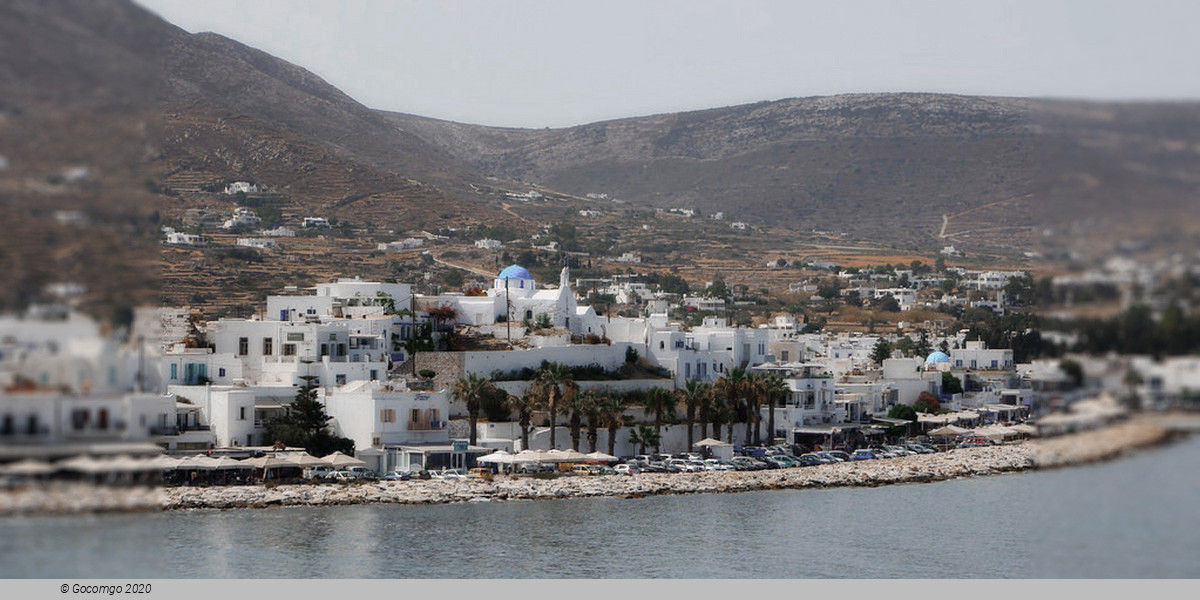Paros

Paros is a Greek island in the central Aegean Sea. One of the Cyclades island group, it lies to the west of Naxos, from which it is separated by a channel about 8 kilometers wide. It lies approximately 150 km southeast of Piraeus. The Municipality of Paros includes numerous uninhabited offshore islets totaling 196.308 square kilometers of land. Its nearest neighbor is the municipality of Antiparos, which lies to its southwest. In ancient Greece, the city-state of Paros was located on the island. Historically, Paros was known for its fine white marble, which gave rise to the term "Parian" to describe marble or china of similar qualities.
History
Antiquity
The story that Paros of Parrhasia colonized the island with Arcadians is an etymological fiction of the type that abounds in Greek legends. Ancient names of the island are said to have been Plateia (or Pactia), Demetrias, Strongyle (meaning round, due to the round shape of the island), Hyria, Hyleessa, Minoa and Cabarnis.
The island later received from Athens a colony of Ionians under whom it attained a high degree of prosperity. It sent out colonies to Thasos and Parium on the Hellespont. In the former colony, which was planned in the 15th or 18th Olympiad, the poet Archilochus, a native of Paros, is said to have taken part. As late as 385 BC the Parians, in conjunction with Dionysius of Syracuse, founded a colony on the Illyrian island of Pharos (Hvar).
Shortly before the Persian War, Paros seems to have been a dependency of Naxos. In the first Greco-Persian War (490 BC), Paros sided with the Persians and sent a trireme to Marathon to support them. In retaliation, the capital was besieged by an Athenian fleet under Miltiades, who demanded a fine of 100 talents. But the town offered vigorous resistance, and the Athenians were obliged to sail away after a siege of 26 days, during which they had wasted the island. It was at a temple of Demeter Thesmophoros in Paros that Miltiades received the wound from which he died. By means of an inscription, Ross was able to identify the site of the temple; it lies, as Herodotus suggests, on a low hill beyond the boundary of the town.
Paros also sided with shahanshah Xerxes I of Persia against Greece in the second Greco-Persian War (480–479 BC), but, after the battle of Artemisium, the Parian contingent remained inactive at Kythnos as they watched the progression of events. For their support of the Persians, the islanders were later punished by the Athenian war leader Themistocles, who exacted a heavy fine.
Under the Delian League, the Athenian-dominated naval confederacy (477–404 BC), Paros paid the highest tribute of the island members: 30 talents annually, according to the estimate of Olympiodorus (429 BC). This implies that Paros was one of the wealthiest islands in the Aegean. Little is known about the constitution of Paros, but inscriptions seem to show that it was modeled on the Athenian democracy, with a boule (senate) at the head of affairs. In 410 BC, Athenian general Theramenes discovered that Paros was governed by an oligarchy; he deposed the oligarchy and restored the democracy. Paros was included in the second Athenian confederacy (the Second Athenian League 378–355 BC). In c. 357 BC, along with Chios, it severed its connection with Athens.
From the inscription of Adule, it is understood that the Cyclades, which are presumed to include Paros, were subjected to the Ptolemies, the Hellenistic dynasty (305–30 BC) that ruled Egypt. Paros then became part of the Roman Empire and later of the Byzantine Empire, its Greek-speaking successor state.
Crusades
In 1204, the soldiers of the Fourth Crusade seized Constantinople and overthrew the Byzantine Empire. Although a residual Byzantine state known as the Empire of Nicaea survived the Crusader onslaught and eventually recovered Constantinople (1261), many of the original Byzantine territories, including Paros, were lost permanently to the crusading powers. Paros became subject to the Duchy of the Archipelago, a fiefdom made up of various Aegean islands ruled by a Venetian duke as a nominal vassal of a succession of crusader states. In practice, however, the duchy was always a client state of the Republic of Venice.
Ottoman era and independence
In 1537, Paros was conquered by the Ottoman Turks and remained under the Ottoman Empire until the Greek War of Independence (1821–1829). During the Russo-Turkish War (1768–1774) in 1770–1775, Naoussa Bay was the home base for the Russian Archipelago Squadron of Count Alexey Orlov. Under the Treaty of Constantinople (1832), Paros became part of the newly independent Kingdom of Greece, the first time the Parians had been ruled by fellow Greeks for over six centuries. At this time, Paros became the home of a heroine of the nationalist movement, Manto Mavrogenous, who had both financed and fought in the war for independence. Her house, near Ekatontapiliani church, is today a historical monument.
On 26 September 2000, the ferry MS Express Samina collided with the Portes islets off the bay of Parikia, killing 82 of those on board.

